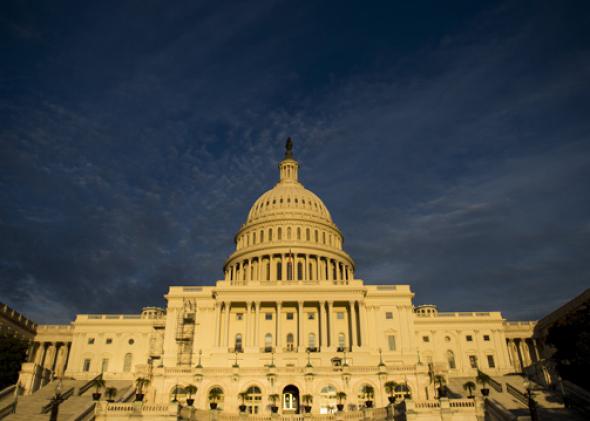On Oct. 1, the government will shut down. This is a bit of an embarrassment for the country and an inconvenience for many Americans, but hardly a catastrophe. On Oct. 17 something different—something more obscure but much worse—may happen. The government will breach what’s known as the debt ceiling. These two events are occurring close in time and are tied up with related political issues, so it’s easy to get confused about which is which and what matters most. This is how to keep them straight.
A “shutdown” occurs when Congress does not pass appropriations bills to fund what are known as “discretionary” spending programs. The programs that aren’t discretionary are “mandatory” spending. That includes Social Security, Medicare, Medicaid, most of the new Obamacare spending, some farm subsidies, and a handful of other measures. Mandatory spending is spending that simply continues on autopilot until Congress steps in and changes the law. If you’re eligible for a Social Security check, that check keeps coming in the mail unless or until Congress takes an affirmative step to amend the Social Security Act.
Discretionary spending, by contrast, is money that Congress appropriates on what’s traditionally been an annual cycle. A law is passed saying that such-and-such agency has X amount of money to spend over such-and-such amount of time on this or that. When the parties in Congress can’t come together on appropriations bills, they often pass what’s known as a continuing resolution that essentially instructs the government to extend the last appropriations bill forward in time.
The shutdown that will likely happen tomorrow is happening because the most recent continuing resolution is set to expire. House Republicans keep writing new continuing resolutions that fund the government while simultaneously delaying or repealing key elements of the Affordable Care Act. Senate Democrats keep taking those provisions out and sending the “clean” continuing resolution back to the House.
Absent a continuing resolution, the discretionary portions of the federal government lack funding to continue their work and the government goes into “shutdown.”
Except it would obviously be insane to just let convicts out of federal prison. Or to have our deployed soldiers not show up for duty. Or to have airports operate without air traffic controllers or for Secret Service agents to stop guarding the president.
The implementation of a shutdown thus contains a rather large loophole. Personnel who are considered “essential” keep working. The rules governing who does and doesn’t count as essential are a bit open to interpretation, which is why you rarely see a definitive list. But the Office of Management and Budget’s guidance on the subject indicates that the main categories of essential employees are those whose jobs relate to the protection of life and property or the continuation of benefit payments under entitlement programs. Keeping air travel running is also on the list.
Long story short, a government shutdown is problematic but decidedly noncatastrophic. Not because the government isn’t important, but because the prevailing interpretation of the law is specifically designed to avoid catastrophe.
The debt ceiling is another matter. Nobody really knows what will happen if we breach the debt ceiling because it’s never happened before. And everyone worries that it will be awful because nobody’s created any legal provision for not making it awful. A breach is sometimes characterized as a default on the national debt. But it’s actually weirder than that. Normally the way things work is that the Treasury Department cuts the checks Congress has told it to cut, collects the taxes Congress has told it to collect, and borrows to cover the difference. But the statutory debt ceiling also instructs Treasury not to borrow more than a certain amount of money. When we hit the debt ceiling on Oct. 17, Treasury will lack the legal authority to borrow any more money to close the gap between spending and tax revenue.
At that point, there are basically three options. One is President Obama could decide that the government’s legal obligation to spend (and certain elements of the 14th Amendment) trump the statutory debt ceiling, and just order the Treasury to sell more bonds. The second option is Obama could instruct the Treasury to pay some of the government’s bills and just not pay the rest. The third option is to pay nobody. All three of these options face the same basic problem of seeming to be illegal. (The second one also faces the problem that Treasury says it lacks the logistical capacity to do it.)
The general consensus is that the third option would, among other things, provoke a global financial crisis by causing a default on U.S. treasury bonds—bonds that are meant to be the safest asset in the financial system. The first option may avoid this fate, but perhaps not. It’s difficult to imagine financial markets would be undisturbed by the prospect. And in general, simply nobody knows what anyone should do about anything if the debt ceiling is breached. Unlike with the shutdown, there is no overriding OMB guidance. There are no rules to spell out essential versus nonessential services. Officially, at least, there’s no contingency planning at all. It’s just a kind of terrifying world of uncertainty.
And that’s the big difference between these two events. There hasn’t been a government shutdown in a while but they were common in the 1970s and 1980s. They’re a big deal in Washington, D.C. because federal employees don’t get paid when they happen. But as long as it doesn’t last too long, it’ll be fine. A debt ceiling breach, by contrast, is completely unprecedented. There’s no guarantee that it’ll lead to a worldwide financial panic and a massive global depression, but there’s honestly no guarantee that it won’t. Nobody knows what will happen, and you should find that prospect terrifying.
Read the rest of Slate’s coverage of the government shutdown.
